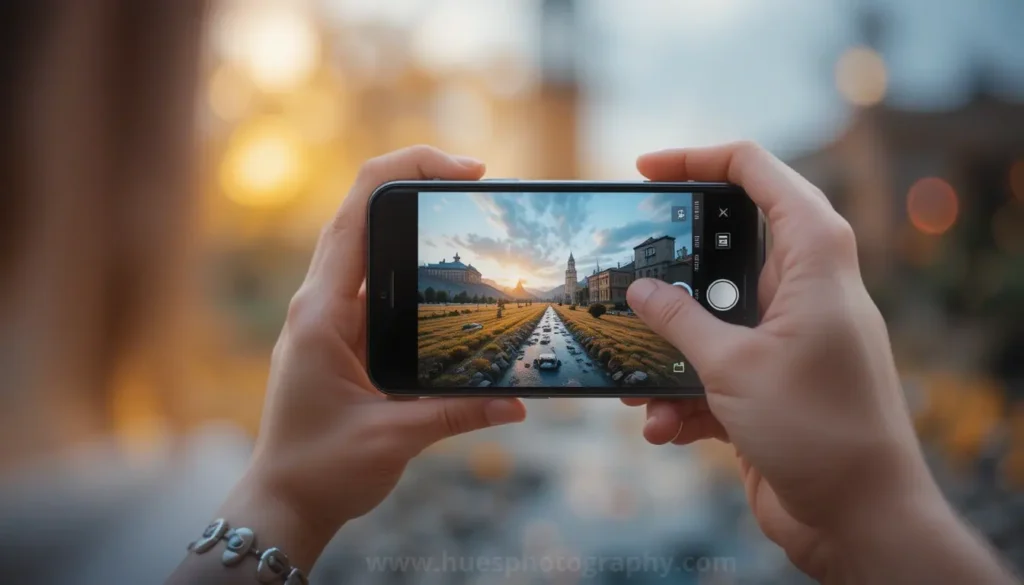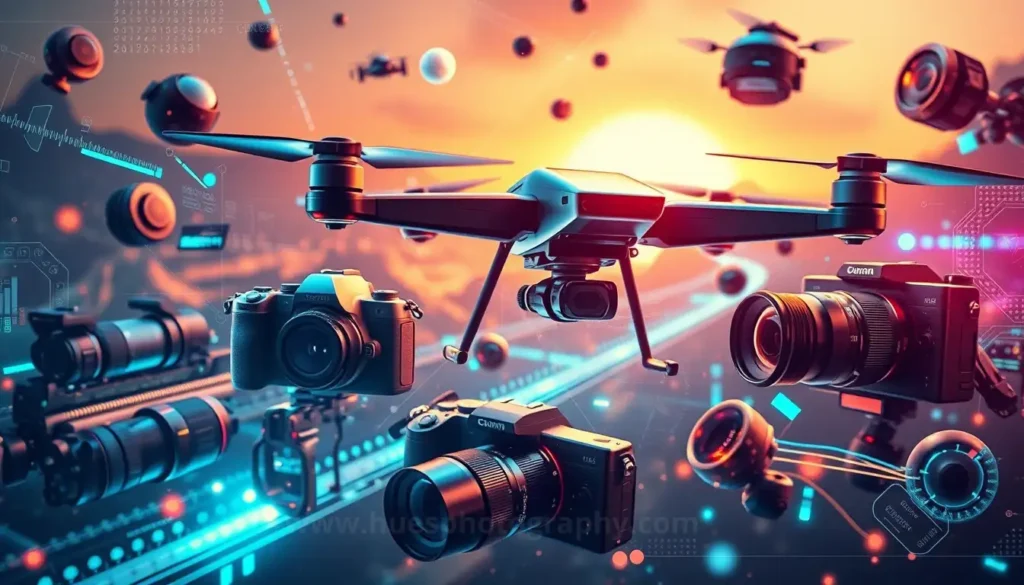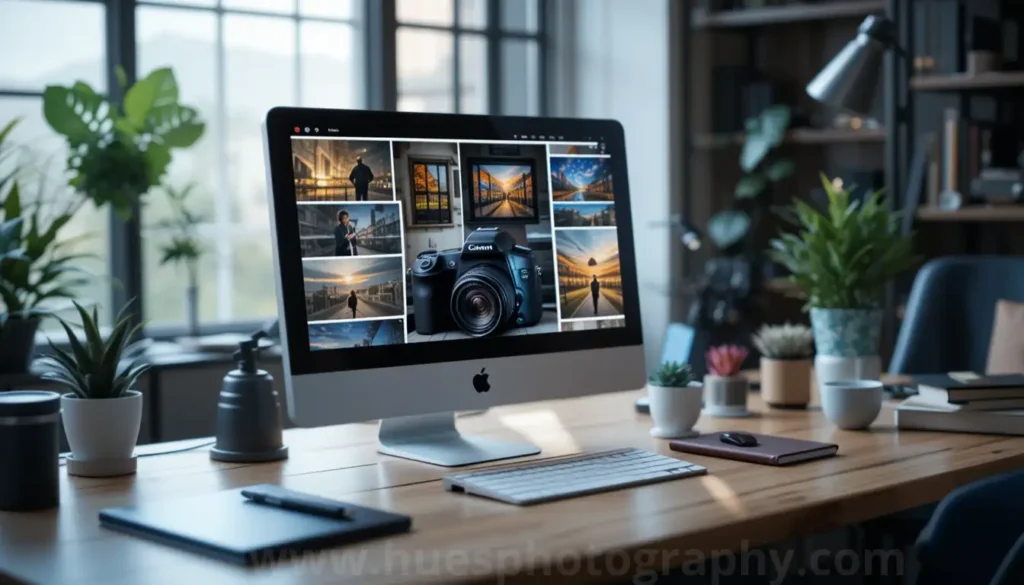The world of photography is constantly evolving, shaped by technological advancements, artistic movements, and shifting societal values. As we enter 2024, photography continues to be a powerful medium for storytelling, creative expression, and commercial success. Whether you’re a professional photographer or an enthusiast, staying up-to-date with the latest trends is essential to remaining competitive and innovative. Let’s explore the top photography trends for 2024 that are pushing the boundaries of this art form.
Rise of AI in Photography
One of the most groundbreaking changes in photography today is the integration of artificial intelligence (AI). AI is not just a futuristic concept; it’s already here, transforming how we capture, edit, and process images.
AI-Powered Editing Tools
AI-driven editing software, like Adobe Sensei or Skylum Luminar, revolutionizes post-production. These tools analyze images and suggest or automatically apply edits, saving photographers countless hours.
Simplifying Post-Production
AI’s ability to simplify complex editing processes is a game-changer in photography trends. Tasks like adjusting exposure, correcting colors, and retouching skin can now be automated, allowing photographers to focus on creativity rather than tedious adjustments.
Creating Unique Effects
AI isn’t just about automating the mundane; it’s also creating opportunities for unique effects. Tools like Deep Dream or Prisma apply artistic styles to photos, generating results that blur the line between photography and digital art.
AI in Camera Hardware
Camera makers are progressively incorporating AI into their devices, aligning with current Photography Trends. This makes for smarter, more intuitive devices that can assist photographers in capturing the perfect shot.
Smart Cameras and Real-Time AI
Cameras like the Sony Alpha series or the Google Pixel smartphones use AI to adjust settings in real-time, reflecting current Photography Trends. The camera can recognize scenes, detect faces, and fine-tune exposure automatically.
Autofocus and Exposure with AI
AI is also improving autofocus capabilities, allowing for more accurate tracking of moving subjects, even in difficult lighting conditions. Whether it’s wildlife photography or action sports, AI-enhanced autofocus makes it easier to get crisp, clear shots.
The Comeback of Film Photography

In a digital world, the resurgence of film photography may seem surprising, but it’s a trend that continues to gain momentum in 2024. The film offers a tangible, nostalgic experience that digital photography sometimes lacks.
Nostalgia-Driven Photography
Many photographers are turning to film to capture a sense of nostalgia. The grain, color, and imperfections of film evoke an emotional quality that’s hard to replicate digitally.
Hybrid Techniques Combining Digital and Film
Some are blending the best of both worlds by using film for certain projects and digital for others. Additionally, digital cameras with film simulation modes—like Fujifilm’s X-series—allow photographers to mimic the aesthetic of film without the hassle of developing negatives.
Instant Film Cameras
Instant film cameras like Polaroids and Fujifilm Instax have also made a strong comeback, driven by their simplicity and the joy of having a physical print in seconds.
Film Simulation Modes on Digital Cameras
Many digital cameras now offer film simulation modes that replicate the look of classic film stocks, combining modern convenience with a retro aesthetic.
Drone Photography is Soaring Higher

Drone photography has been around for a few years, but in 2024, it’s reaching new heights. With improved technology, drones are becoming more accessible and versatile.
Advanced Drone Features
Drone cameras are now equipped with cutting-edge features, such as 8K video recording and 360-degree photography. These features allow for incredibly high-quality images from unique perspectives that were once impossible.
8K Video and 360-Degree Photography
The ability to shoot in 8K resolution or create immersive 360-degree shots is pushing the creative boundaries for drone photography, particularly in industries like real estate and tourism.
Drone Use in Commercial Projects
Drones are increasingly being used for commercial photography, reflecting one of the latest Photography Trends. Real estate agents, wedding photographers, and filmmakers all benefit from the unique angles and sweeping views drones can provide.
Real Estate
Aerial shots of properties offer a comprehensive view that ground-level photography can’t. Drones allow potential buyers to see homes in their entirety, making them an invaluable tool in real estate marketing.
Weddings and Event Photography
In wedding and event photography, drones capture stunning overhead views, adding a cinematic flair to the final product.
The Growth of Smartphone Photography

Smartphone cameras have come a long way. In 2024, mobile photography is becoming increasingly professional, rivaling DSLR cameras in many aspects.
Smartphones with Professional-Grade Cameras
Phones like the iPhone 15 Pro and Google Pixel 8 are equipped with cameras that offer features like optical zoom, low-light capabilities, and AI-driven enhancements. These advancements make smartphones a go-to tool for many photographers, both amateur and professional.
Computational Photography and AI Integration
Smartphones are now leveraging computational photography—using AI to enhance images as they’re being captured. This means better dynamic range, improved night mode shots, and the ability to shoot RAW photos directly from your phone.
The Rise of Mobile-First Creators
With the growth of social media platforms like Instagram and TikTok, more photographers are shooting and editing on their phones. Mobile-first creators are changing the game, using smartphones to build successful photography careers.
Influencers and Social Media
Many influencers and content creators now rely on their smartphones for both capturing and editing photos, thanks to the accessibility and quality of mobile cameras, keeping up with the latest Photography Trends.
Sustainable and Ethical Photography
As environmental concerns become more pressing, photographers are becoming more conscious of the sustainability and ethics of their work.
Eco-Friendly Gear and Packaging
Camera manufacturers are beginning to produce more eco-friendly gear, from sustainable packaging to energy-efficient cameras and accessories.
Ethical Storytelling in Photojournalism
Ethical considerations are also becoming a focus, particularly in photojournalism. Photographers are more aware of the impact their images have on subjects and are striving to tell stories with greater sensitivity and integrity.
Virtual Reality (VR) and 360-Degree Photography

VR and 360-degree photography offer new ways to create immersive experiences. This trend is especially popular in industries like travel, real estate, and product photography.
Immersive Experiences in Travel Photography
Travel photographers are using VR to transport viewers to a destination, offering a fully immersive experience that goes beyond traditional photography.
VR in Commercial and Product Photography
In commercial photography, VR allows potential customers to interact with products in a 3D space, making it a powerful tool for marketing.
Minimalist Photography Trends
Minimalism remains a strong trend in 2024, focusing on simplicity and clean compositions. The “less is more” approach creates impactful images by stripping away distractions.
Embracing Simplicity in Composition
Photographers are turning to minimalist techniques to emphasize subjects and create serene, uncluttered images.
Negative Space as a Powerful Element
Negative space—intentionally leaving large areas of the frame empty—can add a dramatic effect, making the subject stand out more.
Vibrant and Bold Color Trends
Vivid colors are making a comeback in 2024. Photographers are experimenting with retro and neon color palettes, pushing saturation to its limits.
Return of Retro and Neon Colors
Inspired by past decades, photographers are incorporating bold, vibrant hues into their work, creating eye-catching, visually dynamic photos.
Playing with Saturation and Contrast
High saturation and contrast are being used to bring energy and emotion to images, making colors pop and drawing the viewer’s attention, reflecting current photography trends.
Storytelling Through Visuals

Photography has always been a storytelling medium, and in 2024, this trend is more important than ever. Visual storytelling allows photographers to connect with their audience on a deeper, emotional level.
Documentary-Style Photography
Photographers are adopting documentary-style techniques to capture authentic, candid moments. This trend emphasizes storytelling over perfection, with an emphasis on real-life situations.
Capturing Authentic Moments
Authenticity is key, as viewers crave images that feel genuine and raw. Photographers are moving away from overly staged shots in favor of capturing life as it unfolds.
The Rise of Personal Branding in Photography
In 2024, photographers are more than just image-makers—they’re brands. Personal branding has become a central focus for many creators, as they build businesses around their unique style and vision.
Creators Focusing on Building a Brand Identity
Photographers are establishing personal brands by developing consistent aesthetics and themes across their portfolios and social media platforms.
Personalized Photoshoots for Entrepreneurs
Customized photoshoots for influencers, entrepreneurs, and business owners have become a booming niche, as these individuals seek professional images to enhance their brands.
Cinematic Photography: Capturing the Drama of the Movies in Still Images

Cinematic photography is all about creating visually stunning images that feel like they’ve been plucked straight from a movie scene. It’s not just about taking beautiful photos, but about evoking emotions, telling a story, and using light, color, and composition to convey drama and mood. This approach is one of the most captivating photography trends, blending artistry and technique to transform ordinary moments into extraordinary visual narratives.
What is Cinematic Photography?
Cinematic photography refers to the process of applying techniques used in filmmaking to still photography. This means using deliberate lighting, framing, and angles to create images that have the feel of a film still. The objective is to evoke emotion and tell a story in a single shot, often with a sense of depth and atmosphere that draws viewers in.
How to Achieve a Cinematic Look in Photography
Creating cinematic images requires an understanding of certain key elements. These include:
- Lighting and Shadows
Cinematic photography often mimics the lighting used in films. This can mean dramatic lighting with high contrast between light and shadow or soft, diffuse lighting to create a more ethereal atmosphere. Positioning light sources thoughtfully is key—using side lighting or backlighting often adds depth and drama to the scene.
- Wide Aspect Ratios
Films often use wider aspect ratios, like 16:9, which can help give a cinematic feel to your images. Photographers can replicate this by either cropping their images to a wider frame or shooting with a lens that has a wider field of view.
- Color Grading
In cinematic photography, color grading plays a major role. By altering the hues and tones, photographers can mimic the moody or vibrant looks often seen in films. Many cinematic shots use teal and orange as a color palette (orange for skin tones, teal for shadows) because these complementary colors create a striking contrast.
- Shallow Depth of Field
A shallow depth of field is commonly used in cinematic photography to isolate the subject from the background. By using a wide aperture, you can blur the background, drawing focus to your subject and giving the image a film quality.
- Storytelling Elements
One of the hallmarks of cinematic photography is the emphasis on storytelling. Whether it’s a moment of action, emotion, or tension, there’s always a narrative in the image. Think about how characters interact with their environment and how you can use that interaction to tell a story within a single frame.
- Composition Techniques
Symmetry, leading lines, and the rule of thirds are crucial compositional elements in cinematic photography. The way elements are arranged in the frame helps guide the viewer’s eye, just as it does in cinema. Framing your subject within architectural elements, doorways, or windows can create an especially cinematic feel.
Influences of Film on Cinematic Photography Styles
Photographers often look to the cinema for inspiration. Here are some ways that cinematic techniques influence photography:
- Film Noir Lighting: Inspired by classic noir films, this style uses deep shadows, strong contrast, and dramatic lighting to create moody, mysterious images.
- Natural Light in Indie Films: Some cinematic photographers take inspiration from indie films, which often use natural lighting and handheld cameras to give a raw, authentic feel. This approach lends a sense of intimacy and realism to the images.
- Epic Fantasy/Adventure Themes: Large-scale, epic films like Lord of the Rings or Mad Max inspire wide, dramatic landscapes in photography. The use of expansive scenery with a small, isolated subject can create a sense of wonder or awe.
- Romantic Cinematography: Borrowing from romantic films, photographers use soft lighting and pastel tones to create a dreamy, intimate atmosphere.
Using Cinematic Lighting in Photography
Lighting plays an enormous role in how cinematic an image feels. There are several ways to emulate the lighting styles of movies:
- Three-Point Lighting: A standard in cinematography, this lighting setup involves using three lights: a key light to illuminate the subject, a fill light to soften shadows, and a backlight to add depth and separation from the background.
- Golden Hour Lighting: The “golden hour,” the period shortly after sunrise or before sunset, provides a warm, soft glow that is ideal for creating cinematic photos. This natural lighting creates a visually pleasing, filmic atmosphere.
- Hard Light for Drama: In contrast, using hard, direct light can introduce tension and drama to a scene, similar to what you’d see in action or thriller movies.
Creating Cinematic Portraits
Portrait photography can also benefit from a cinematic touch. By using film-inspired lighting, framing, and posing, photographers can create portraits that feel like they belong in a movie. Here are some techniques to apply:
- Emotion in Focus: Just as film directors guide actors to express specific emotions, cinematic photographers focus on conveying emotion through facial expressions and body language. Capturing authentic feelings makes the portrait more engaging.
- Dynamic Poses: Instead of static poses, cinematic portraits often include movement or interaction with the environment, as though the subject has been caught in a moment of action.
- Environmental Portraiture: Cinematic portraits often place the subject within a meaningful environment that adds context to the story. This could be a dramatic natural landscape or a carefully styled indoor setting.
The Demand for Professional Photographers
Despite the rise of smartphone photography, there is still a strong demand for professional photographers in specific niches.
Niche Markets: From Pet Photography to Corporate Events
Photographers are finding success in niche markets, such as pet photography, corporate headshots, and events, where clients value expertise and high-quality results.
The Role of Photographers in Brand Campaigns
Brands are increasingly turning to professional photographers to create standout campaigns that resonate with their target audience, recognizing the value of skill and experience in visual storytelling.
Conclusion
Photography in 2024 is an exciting blend of technology and creativity. From AI and VR to the revival of film and minimalist aesthetics, the landscape is evolving in fascinating ways. Staying ahead of these trends will help photographers remain innovative and competitive in a rapidly changing industry.
FAQs
1. What is the most significant trend in photography for 2024?
- The integration of AI into both hardware and software is perhaps the most significant trend, as it’s reshaping how photographers capture and edit images.
2. How is AI changing photography?
- AI simplifies post-production by automating tasks like exposure adjustment and color correction, and it’s also being used in cameras for real-time adjustments, autofocus, and scene recognition.
3. Will film photography continue to rise in popularity?
- Yes, film photography is expected to continue its rise, driven by a sense of nostalgia and the unique, tangible qualities film offers compared to digital.
4. Is drone photography only for professionals?
- No, drones are becoming more accessible and user-friendly, allowing hobbyists and professionals alike to capture stunning aerial images.
5. How can I start using VR in my photography work?
- To get started with VR photography, invest in a 360-degree camera and explore editing tools that allow for immersive, interactive experiences.
6. How does drone photography enhance your photography experience?
- Drones provide unique aerial perspectives that are impossible to achieve from the ground. They allow photographers to capture sweeping landscapes, dynamic real estate shots, and cinematic event footage, all while offering flexibility and creative freedom.
7. Is film photography expensive compared to digital photography?
- Film photography can be more expensive due to the cost of film rolls, development, and printing. However, many photographers believe the aesthetic and tactile qualities of film justify the expense, especially for artistic or nostalgic projects.
8. How are smartphones competing with professional cameras?
- Smartphones are integrating professional-grade features like multiple lenses, computational photography, and advanced AI-driven editing. While DSLRs and mirrorless cameras still offer superior image quality in many cases, smartphones are becoming more capable of delivering impressive results, especially for everyday and social media use.
9. How can I incorporate sustainability into my photography practice?
- To adopt sustainable practices, consider using eco-friendly camera gear, minimizing waste in packaging and production, and supporting brands that prioritize environmental sustainability. You can also focus on telling stories about environmental conservation through your work.
10. What are some good resources for learning about new photography trends?
- Following photography blogs, online courses, YouTube channels, and industry magazines are great ways to stay updated on new trends. Communities on social media, such as Instagram and Reddit, also offer insights and inspiration from fellow photographers.


